电子科技大学:《矩阵理论 Matrix Theory》课程教学资源(课件讲稿)07 Matrix Inversion
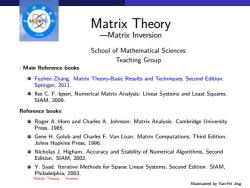
Matrix Theory -Matrix Inversion School of Mathematical Sciences Teaching Group Main Reference books Fuzhen Zhang.Matrix Theory-Basic Results and Techniques,Second Edition. Springer,2011. llse C.F.Ipsen,Numerical Matrix Analysis:Linear Systems and Least Squares. S1AM,2009. Reference books: o Roger A.Horn and Charles A.Johnson:Matrix Analysis.Cambridge University Press,1985. Gene H.Golub and Charles F.Van Loan:Matrix Computations,Third Edition. Johns Hopkins Press,1996. Nicholas J.Higham.Accuracy and Stability of Numerical Algorithms,Second Edition.SIAM,2002. Y.Saad.Iterative Methods for Sparse Linear Systems,Second Edition.SIAM, Philadelphia,2003. Matrix Theory Inverse Maintained by Yan-Fei Jing
: Main Reference books Fuzhen Zhang. Matrix Theory-Basic Results and Techniques, Second Edition. Springer, 2011. Ilse C. F. Ipsen, Numerical Matrix Analysis: Linear Systems and Least Squares. SIAM, 2009. Reference books: Roger A. Horn and Charles A. Johnson: Matrix Analysis. Cambridge University Press, 1985. Gene H. Golub and Charles F. Van Loan: Matrix Computations, Third Edition. Johns Hopkins Press, 1996. Nicholas J. Higham. Accuracy and Stability of Numerical Algorithms, Second Edition. SIAM, 2002. Y. Saad. Iterative Methods for Sparse Linear Systems, Second Edition. SIAM, Philadelphia, 2003. Maintained by Yan-Fei Jing Matrix Theory ––Matrix Inversion School of Mathematical Sciences Teaching Group Matrix Theory Inverse
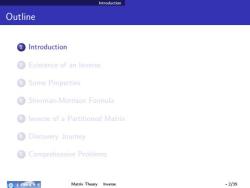
Introduction Outline Introduction Existence of an Inverse ③Some Properties Sherman-Morrison Formula Inverse of a Partitioned Matrix Discovery Journey Comprehensive Problems 争老年这大习 Matrix Theory Inverse -2/35
Introduction Outline 1 Introduction 2 Existence of an Inverse 3 Some Properties 4 Sherman-Morrison Formula 5 Inverse of a Partitioned Matrix 6 Discovery Journey 7 Comprehensive Problems Matrix Theory Inverse - 2/35
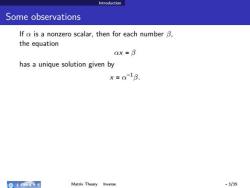
Introduction Some observations If a is a nonzero scalar,then for each number B, the equation ax=B has a unique solution given by x=a1B. 奇电有这头 Matrix Theory Inverse -3/35
Introduction Some observations If α is a nonzero scalar, then for each number β, the equation αx = β has a unique solution given by x = α −1 β. To prove that α −1β is a solution, write α(α −1 β) = (αα −1 )β = (1)β = β. Uniqueness follows because if x1 and x2 are two solutions, then αx1 = β = αx2 ⇒ α −1 (αx1) = α −1 (αx2) ⇒ (α −1α)x1 = (α −1α)x2 ⇒ (1)x1 = (1)x2 ⇒ x1 = x2. Matrix Theory Inverse - 3/35
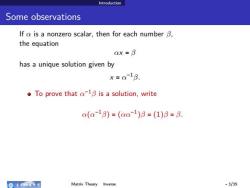
Introduction Some observations If a is a nonzero scalar,then for each number B, the equation aX=B has a unique solution given by x=a1B. o To prove that a-13 is a solution,write a(a-13)=(aa-1)3=(1)B=3. 奇电有这头 Matrix Theory Inverse -3/35
Introduction Some observations If α is a nonzero scalar, then for each number β, the equation αx = β has a unique solution given by x = α −1 β. To prove that α −1β is a solution, write α(α −1 β) = (αα−1 )β = (1)β = β. Uniqueness follows because if x1 and x2 are two solutions, then αx1 = β = αx2 ⇒ α −1 (αx1) = α −1 (αx2) ⇒ (α −1α)x1 = (α −1α)x2 ⇒ (1)x1 = (1)x2 ⇒ x1 = x2. Matrix Theory Inverse - 3/35
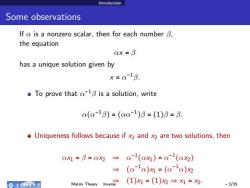
Introduction Some observations If a is a nonzero scalar,then for each number B, the equation aX=B has a unique solution given by x=a1B. To prove that a-13 is a solution,write a(a-13)=(aa-1)3=(1)B=3. o Uniqueness follows because if x1 and x2 are two solutions,then ax=B=a为→a-1(ax)=a-1(ax2) →(a1a)x=(a1a)x9 奇电有这女了 Matrix Theory (1)X1=(1)x9→xM=2: .3/35
Introduction Some observations If α is a nonzero scalar, then for each number β, the equation αx = β has a unique solution given by x = α −1 β. To prove that α −1β is a solution, write α(α −1 β) = (αα−1 )β = (1)β = β. Uniqueness follows because if x1 and x2 are two solutions, then αx1 = β = αx2 ⇒ α −1 (αx1) = α −1 (αx2) ⇒ (α −1α)x1 = (α −1α)x2 ⇒ (1)x1 = (1)x2 ⇒ x1 = x2. Matrix Theory Inverse - 3/35

Introduction Some remarks These observations seem pedantic,but they are important in order to see how to make the transition from scalar equations to matrix equations. 色电这女了 Matrix Theory Inverse -4/35
Introduction Some remarks These observations seem pedantic, but they are important in order to see how to make the transition from scalar equations to matrix equations. In particular, these arguments show that in addition to associativity, the properties αα −1 = 1 and α −1α = 1 (1) are the key ingredients. So if we want to solve matrix equations in the same fashion as we solve scalar equations, then a matrix analogue of (1) is needed. Matrix Theory Inverse - 4/35
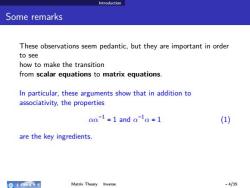
Introduction Some remarks These observations seem pedantic,but they are important in order to see how to make the transition from scalar equations to matrix equations. In particular,these arguments show that in addition to associativity,the properties aa-1=1 and a la=1 (1) are the key ingredients. 色电有这大习 Matrix Theory Inverse -4/35
Introduction Some remarks These observations seem pedantic, but they are important in order to see how to make the transition from scalar equations to matrix equations. In particular, these arguments show that in addition to associativity, the properties αα−1 = 1 and α −1α = 1 (1) are the key ingredients. So if we want to solve matrix equations in the same fashion as we solve scalar equations, then a matrix analogue of (1) is needed. Matrix Theory Inverse - 4/35

Introduction Some remarks These observations seem pedantic,but they are important in order to see how to make the transition from scalar equations to matrix equations. In particular,these arguments show that in addition to associativity,the properties aa1=1 and aa=1 (1) are the key ingredients. So if we want to solve matrix equations in the same fashion as we solve scalar equations,then a matrix analogue of(1)is needed. 争老年这大习 Matrix Theory Inverse -4/35
Introduction Some remarks These observations seem pedantic, but they are important in order to see how to make the transition from scalar equations to matrix equations. In particular, these arguments show that in addition to associativity, the properties αα−1 = 1 and α −1α = 1 (1) are the key ingredients. So if we want to solve matrix equations in the same fashion as we solve scalar equations, then a matrix analogue of (1) is needed. Matrix Theory Inverse - 4/35

Introduction Some remarks Inversion of matrices is more complicated than inversion of scalars. 务老环这女子 Matrix Theory Inverse -5/35
Introduction Some remarks Inversion of matrices is more complicated than inversion of scalars. There is only one scalar that does not have an inverse : 0. There are many matrices without inverses. How to determine an inverse with respect to matrix multiplication? Matrix Theory Inverse - 5/35
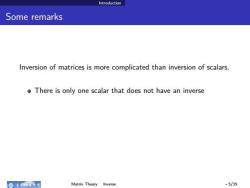
Introduction Some remarks Inversion of matrices is more complicated than inversion of scalars. o There is only one scalar that does not have an inverse 命电有这女 Matrix Theory Inverse -5/35
Introduction Some remarks Inversion of matrices is more complicated than inversion of scalars. There is only one scalar that does not have an inverse : 0. There are many matrices without inverses. How to determine an inverse with respect to matrix multiplication? Matrix Theory Inverse - 5/35
按次数下载不扣除下载券;
注册用户24小时内重复下载只扣除一次;
顺序:VIP每日次数-->可用次数-->下载券;
- 电子科技大学:《矩阵理论 Matrix Theory》课程教学资源(课件讲稿)06 Matrix Transposition and Related.pdf
- 电子科技大学:《矩阵理论 Matrix Theory》课程教学资源(课件讲稿)05 Special matrices-matlab.pdf
- 电子科技大学:《矩阵理论 Matrix Theory》课程教学资源(课件讲稿)04 Matrix space and special ones.pdf
- 电子科技大学:《矩阵理论 Matrix Theory》课程教学资源(课件讲稿)03 Matrices-special matrices.pdf
- 电子科技大学:《矩阵理论 Matrix Theory》课程教学资源(课件讲稿)02 Matrices Intro.pdf
- 电子科技大学:《矩阵理论 Matrix Theory》课程教学资源(课件讲稿)01 Vector space.pdf
- 电子科技大学:《矩阵理论 Matrix Theory》课程教学资源(课件讲稿)第五章 矩阵函数及其应用.pdf
- 电子科技大学:《矩阵理论 Matrix Theory》课程教学资源(课件讲稿)第二章 向量与矩阵范数.pdf
- 电子科技大学:《矩阵理论 Matrix Theory》课程教学资源(课件讲稿)第三章 矩阵分解(李厚彪).pdf
- 电子科技大学:《矩阵理论 Matrix Theory》课程教学资源(课件讲稿)第一章 线性代数基础与核心思想.pdf
- 电子科技大学:《数学物理方程与特殊函数 Mathematical Physics Equations with Special Function》课程教学资源(课件讲稿)第八章 Legendre多项式 §8.2 母函数与正交性.pdf
- 电子科技大学:《数学物理方程与特殊函数 Mathematical Physics Equations with Special Function》课程教学资源(课件讲稿)第八章 Legendre多项式 §8.1 Legendre方程与求解.pdf
- 电子科技大学:《数学物理方程与特殊函数 Mathematical Physics Equations with Special Function》课程教学资源(课件讲稿)第七章 Bessel函数 §7.4 Bessel函数应用.pdf
- 电子科技大学:《数学物理方程与特殊函数 Mathematical Physics Equations with Special Function》课程教学资源(课件讲稿)第七章 Bessel函数 §7.3 Bessel函数的正交性.pdf
- 电子科技大学:《数学物理方程与特殊函数 Mathematical Physics Equations with Special Function》课程教学资源(课件讲稿)第七章 Bessel函数 §7.2 Bessel函数的母函数.pdf
- 电子科技大学:《数学物理方程与特殊函数 Mathematical Physics Equations with Special Function》课程教学资源(课件讲稿)第七章 Bessel函数 §7.1 Bessel方程的求解.pdf
- 电子科技大学:《数学物理方程与特殊函数 Mathematical Physics Equations with Special Function》课程教学资源(课件讲稿)第六章 Green函数法 6.3 基本解.pdf
- 电子科技大学:《数学物理方程与特殊函数 Mathematical Physics Equations with Special Function》课程教学资源(课件讲稿)第六章 Green函数法 6.2 Dirichlet问题求解(2/2).pdf
- 电子科技大学:《数学物理方程与特殊函数 Mathematical Physics Equations with Special Function》课程教学资源(课件讲稿)第六章 Green函数法 6.2 Dirichlet问题求解(1/2).pdf
- 电子科技大学:《数学物理方程与特殊函数 Mathematical Physics Equations with Special Function》课程教学资源(课件讲稿)第六章 Green函数法 6.1 Green公式(2/2).pdf
- 电子科技大学:《矩阵理论 Matrix Theory》课程教学资源(课件讲稿)08 Unitary Matrices.pdf
- 电子科技大学:《矩阵理论 Matrix Theory》课程教学资源(课件讲稿)09 Vector norm.pdf
- 电子科技大学:《矩阵理论 Matrix Theory》课程教学资源(课件讲稿)10 matrix norm.pdf
- 南京大学:《离散数学》课程教学资源(PPT课件讲稿)Lecture 01 命题逻辑(主讲:姚远).pptx
- 南京大学:《离散数学》课程教学资源(PPT课件讲稿)Lecture 02 谓词逻辑初步.pptx
- 南京大学:《离散数学》课程教学资源(PPT课件讲稿)Lecture 03 证明方法.pptx
- 南京大学:《离散数学》课程教学资源(PPT课件讲稿)Lecture 04 集合及其运算.pptx
- 南京大学:《离散数学》课程教学资源(PPT课件讲稿)Lecture 05 关系与函数.pptx
- 南京大学:《离散数学》课程教学资源(PPT课件讲稿)Lecture 06 集合的基数.pptx
- 南京大学:《离散数学》课程教学资源(PPT课件讲稿)Lecture 07 数论基础.pptx
- 南京大学:《离散数学》课程教学资源(PPT课件讲稿)Lecture 08 归纳与递归.pptx
- 南京大学:《离散数学》课程教学资源(PPT课件讲稿)Lecture 09 计数.pptx
- 南京大学:《离散数学》课程教学资源(PPT课件讲稿)Lecture 10 离散概率.pptx
- 南京大学:《离散数学》课程教学资源(PPT课件讲稿)Lecture 11 关系的性质.pptx
- 南京大学:《离散数学》课程教学资源(PPT课件讲稿)Lecture 12 等价关系与偏序关系.pptx
- 南京大学:《离散数学》课程教学资源(PPT课件讲稿)Lecture 13 群伦导引.pptx
- 南京大学:《离散数学》课程教学资源(PPT课件讲稿)Lecture 14 子群及其陪集.pptx
- 南京大学:《离散数学》课程教学资源(PPT课件讲稿)Lecture 15 循环群与群同构.pptx
- 南京大学:《离散数学》课程教学资源(PPT课件讲稿)Lecture 16 代数格.pptx
- 南京大学:《离散数学》课程教学资源(PPT课件讲稿)Lecture 17 布尔代数.pptx
